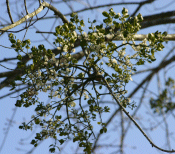I have what I think is a Peace Lilly. But, it has beautiful lightly colored coral flowers, but when I bring it in for the winter it seems to do badly. The leaves get big brown dead spots on them and eventually I have to cut them off. Last year I almost lost it, it came back when I put it outside. What am I doing wrong? Help Robin
reply
Thanks for writing to Flower Shop Network with your plant question.
Based on your description, I am going to assume that you have a variety of Anthurium, which is a plant that is related to the Peace Lily (in the Aroid family) and has similar flowers. Below is a picture of an anthurium hybrid called “Lady Ruth”. Could this be your plant? Anthuriums are native to the humid jungles of South America, and as such they need a humid environment indoors in order to thrive. This is often difficult to achieve indoors, especially during the winter when the heat is on. You can increase the humidity around the plant by placing the pot on top of a shallow tray that is filled with pebbles which are kept wet. Do not place the pot down into the water, but allow the pebbles to support the pot above the water line. As water evaporates from the pebbles, a more humid atmosphere will be maintained around the plant. Misting the plant frequently with water can also be beneficial.
Besides dry air, the brown spots you describe can also be casued by over- or under-watering. Over-watering when the plant is not in active growth can be detrimental. Be sure the soil is kept lightly moist, never water-logged. Anthuriums need a highly organic soil that is well-aerated and fast draining. Water when the top inch or so of the potting mixture is dry. In the winter, when the plant is not in active growth, cut back slightly on the watering (but not to the point that the plant wilts). Resume regular watering as the days lengthen in the spring.
Anthuriums prefer bright light, but no direct sun, which can burn the leaves. Fertilize the plant during spring and summer with any standard houseplant food, diluted to half the recommended strength. If fertilizer salts accumulate in the soil (and these may even be present in the soil from the nursery where the plant was produced), tender root hairs can be burned if the potting mix gets too dry, which can also show up as brown spots on the leaves or leaf edges. If this is the case, leach the soil by running water through the pot continuously for 10 or 15 minutes, allowing it to run out the drainage holes in the bottom. We hope this answers your question, Robin. Thanks again for writing to Flower Shop Network!


 Find Your
Find Your 
 Now, mistletoe is something else altogether. Mistletoe is actually a parasite – it draws its nourishment from the resources of another tree or shrub upon which it grows, sending its roots into the host plant’s vascular system to obtain nutrients. There are two types of mistletoe. The one most seen in Christmas decorations in this country is the North American mistletoe, (Phoradendron flavescens). The other, slightly smaller type of mistletoe (Viscum album) is of European origin. Both mistletoes have pale green, leathery leaves and produce small, sticky white berries which are considered poisonous to humans. The European mistletoe grows mostly on apple trees, although it may rarely be seen growing on oaks (a significant detail).
Now, mistletoe is something else altogether. Mistletoe is actually a parasite – it draws its nourishment from the resources of another tree or shrub upon which it grows, sending its roots into the host plant’s vascular system to obtain nutrients. There are two types of mistletoe. The one most seen in Christmas decorations in this country is the North American mistletoe, (Phoradendron flavescens). The other, slightly smaller type of mistletoe (Viscum album) is of European origin. Both mistletoes have pale green, leathery leaves and produce small, sticky white berries which are considered poisonous to humans. The European mistletoe grows mostly on apple trees, although it may rarely be seen growing on oaks (a significant detail). To the Druids, who were the high priests of the ancient pagan religions, the oak tree was sacred, and any mistletoe that was found growing in an oak tree was doubly sacred. During the winter solstice festival of Saturnalia (in honor of Saturn, the Roman god of agriculture), mistletoe was ceremonially harvested from the oak trees with a golden sickle, amid prayers that the recipients of the mistletoe would prosper. Embracing or kissing under the mistletoe was first associated with the Saturnalia festival as a sign of peace and that all bad feelings of the past year were forgiven. Later it became associated with marriage ceremonies as a sign of fertility.
To the Druids, who were the high priests of the ancient pagan religions, the oak tree was sacred, and any mistletoe that was found growing in an oak tree was doubly sacred. During the winter solstice festival of Saturnalia (in honor of Saturn, the Roman god of agriculture), mistletoe was ceremonially harvested from the oak trees with a golden sickle, amid prayers that the recipients of the mistletoe would prosper. Embracing or kissing under the mistletoe was first associated with the Saturnalia festival as a sign of peace and that all bad feelings of the past year were forgiven. Later it became associated with marriage ceremonies as a sign of fertility.

